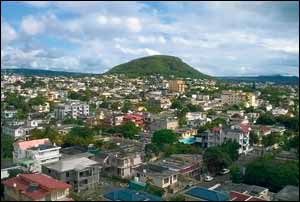 | |
| Little known part of Holocaust history found in Mauritius | |
An auspicious part of Holocaust history is the story of the Atlit detention camp and the Jews who escaped the horrors of Nazi Europe with the hopes of reaching the Holy Land.
However, there’s a forgotten piece of that story, one known even to few local Mauritians — people who live on the very island in which the story took place. On the outskirts of the western Quatre Bornes district on the island of Mauritius sits an unusual cemetery and memorial museum. Buried there are Jewish detainees who died on the island between 1940 and 1945. Its story was “out of sight and out of mind” for Mauritians, Vanessa Calou, a guide at Saint Martin Jewish Cemetery, told me. In 1939, around 3,500 Jews who had managed to gain visas to Latin America decided to attempt to land in Mandatory Palestine, Calou explained. At the time, the British, who controlled the territory, were waging a fierce campaign against illegal immigration to the country and “had already made up their minds to deport all these people”. “It was a punitive measure,” Calou added. The refugees, European Jews arriving from Romania, were travelling on three ships: the Milos, the Pacific and the Atlantic. The passengers on the first two vessels, the Pacific and the Milos, arrived earlier and were transferred by the British to “an old French ship in Haifa named the Patria,” Calou said. When the third ship, the Atlantic, arrived, British soldiers began transferring passengers to the Patria. A short time later, there was an explosion onboard. More than 250 people died in the blast, including some British officers. The Hagana, the pre-state Jewish militia that eventually became the IDF, was against the deportation and wanted to stop the ship from sailing and force the British to negotiate. After the incident, however, the British decided to take all the survivors and house them in the Atlit detention camp. The remaining passengers on the Atlantic were also detained in Atlit, before being deported two weeks later to Mauritius, which was then a British colony. Some 1,580 refugees landed on the island on December 26, 1940. At that time, there were around 400,000 inhabitants living there. Mauritians didn’t know about the deportation. There were rumours weeks before that soon there would be refugees coming to the island but “no one told them about the punitive measures, they lined up by the side of the road to welcome the visitors”, Calou explained. But when the people arrived, they were transferred to the Beau Bassin prison, where they were kept for nearly five years, before being liberated at the end of the Second World War. “During their detention, there was no family life for nearly 18 months,” Calou said. “Then finally, married women were given a pass to be allowed to visit their husbands during certain hours of the day.” “The main reason they were detained is because the British believed there were Nazi spies among them,” Calou said. When the British realised there were no spies among the prisoners, some of them went to work outside the prison and marriage was allowed among the single detainees. “Nearly 60 babies were born here,” Calou proudly told me. “It’s been a dream of mine to visit here all my life, ever since my grandparents were here as refugees,” said Dvir Panzer, an Israeli visiting the cemetery. “My mother was actually born here. When I was growing up, I heard all the time ‘Your mother is from Mauritius,’ but nobody knows about this place.” “I actually took advantage of the new Air Seychelles flight and went to Seychelles, we then said we’re already here, we’ve got to come and check it out,” Panzer said. “We managed to locate my grandfather’s name, my grandmother’s we couldn’t find yet but I found her in a picture here . . . I still don’t know what name to look for.” According to Calou, “there’s a lot of research to be done on this part of history”. She said that only those who lived in the vicinity of the prison knew about this part of history. The story of what happened on the east African island is now being taught in some of the local private schools as it begins to become more known. In the graveyard there are 130 graves, out of which 128 are refugees. “Now we are lighting a torch on a part of history that has remained in the darkness for more than 70 years,” Calou concluded. Much of the story of the Jewish refugees on Mauritius Island is documented in the book, The Mauritian Shekel, by Genevičve Pitot.
If you have a story or an issue you want us to cover, let us know - in complete confidence - by contacting newsdesk@jewishtelegraph.com, 0161-741 2631 or via Facebook / Twitter

|
 QUATRE Bornes in Mauritius
QUATRE Bornes in Mauritius